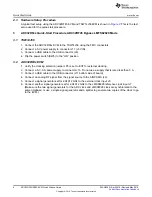
ADC32RF80 Quick-Start Procedure (Digital DDC Block - Decimation Plus NCO) External Clocking
13
SLAU620A – April 2016 – Revised May 2016
Copyright © 2016, Texas Instruments Incorporated
ADC32RF45/RF80 EVM Quick Startup Guide
6. After the firmware download has completed, enter “2949.12M” into the
ADC Output Data Rate
field at
the bottom left corner of the HSDC Pro GUI.
7. Select “Channel 1/2” in the channel select window located at the top middle of the GUI.
8. Click the
Instrument Options
menu at the top of HSDC Pro and select
Reset Board
.
9. Click
Capture
in HSDC Pro to capture data from the ADC.
10. The result should match the example capture in
.
Figure 9. Example Capture from Channel A – 5 Sample Mode
4
ADC32RF80 Quick-Start Procedure (Digital DDC Block - Decimation Plus NCO)
External Clocking
4.1
TSW14J56
1. Connect the ADC32RF80 EVM to the TSW14J56 using the FMC connectors.
2. Connect a 5-V power supply to connector J11 (+5V IN).
3. Connect a USB cable to the USB connector (J9).
4. Flip the power switch (SW6) to the “ON” position.
4.2
ADC32RF80 EVM
1. Verify jumper JP3 is set for position EXT to select external clocking.
2. Connect a 5-V, 3-A power supply to connector J15. Do not use a supply that is rated less than 3 A.
3. Connect a USB cable to the USB connector (J11 bottom side of board).
4. Connect an analog RF signal from a signal source to the AINP SMA (J2).
5. Connect a signal generator set for 2.94912 GHz to the external clock input J5.
6. Connect another signal generator set for 2.94912 GHz to the LMK04828 reference clock input J7.
(Make sure the two signal generators for the ADC clock and LMK04828 clock are synchronized to the
same timebase, or use a single signal generator and a splitter to generate two copies of the clock to go
to the EVM.)




























